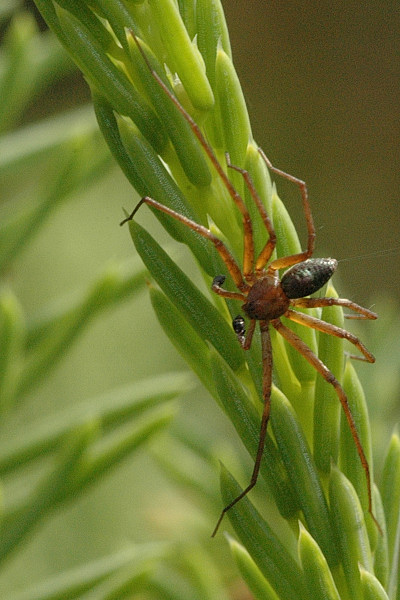Philodromus Aureolus on:
[Wikipedia]
[Google]
[Amazon]
''Philodromus aureolus'', the wandering crab spider, is a mainly European running crab spider of the family

Philodromus aureolus, Hartelholz, Múnich, Alemania, 2020-06-26, DD 54-90 FS.jpg
Philodromus aureolus, Hartelholz, Múnich, Alemania, 2020-06-27, DD 215-226 FS.jpg
Philodromus aureolus, Hartelholz, Múnich, Alemania, 2020-06-26, DD 01-15 FS.jpg
Philodromus aureolus, Hartelholz, Múnich, Alemania, 2020-06-27, DD 228-237 FS.jpg
Philodromus aureolus, Hartelholz, Múnich, Alemania, 2020-06-27, DD 238-253 FS.jpg
{{Taxonbar, from=Q1313508
aureolus
Spiders of Europe
Palearctic spiders
Spiders described in 1757
Taxa named by Carl Alexander Clerck
Philodromidae
Philodromidae, also known as philodromid crab spiders and running crab spiders, is a family of araneomorph spiders first described by Tord Tamerlan Teodor Thorell in 1870 (then known as subfamily Philodrominae within Thomisidae). It contains over ...
. The taxonomy of the species group named after ''Philodromus aureolus'' is in a state of flux and a number of new species have recently been recognised.
Description
Theprosoma
The cephalothorax, also called prosoma in some groups, is a tagma of various arthropods, comprising the head and the thorax fused together, as distinct from the abdomen behind. (The terms ''prosoma'' and ''opisthosoma'' are equivalent to ''cepha ...
often has a broad bright median band, which is plain. The legs are yellowish grey or brown with dark spots. The opisthosoma
The opisthosoma is the posterior part of the body in some arthropods, behind the prosoma (cephalothorax). It is a distinctive feature of the subphylum Chelicerata (arachnids, horseshoe crabs and others). Although it is similar in most respects to a ...
is very variably coloured, brown or yellowish brown, mostly spotted with bright median band and often with a dark cardiac mark that reaches the second pair of sigillae, and with dark chevrons. The male often more intensely patterned, although sometimes males may be plain dark brown.
The body length of a male is 3.5-6.5 mm, that of females 4-8.5 mm.

Biology
''Philodromus aureolus'' hunts by relying on camouflage, stealth and speed to hunt prey. The males are bright green, the females lighterer in colour and it is thought that they can change colour to match their background, as is the case some other members of the ''Philodromus
''Philodromus'' is a genus of philodromid crab spiders. Spiders in this genus are distinctively flattened.
The more than 250 described species are distributed throughout the Holarctic region, with few species reaching into more southern regions. ...
'' group.
They sit and wait on the leaves of bushes and trees to catch any prey that comes into reach. They can also move very rapidly to chase prey down too. This speed can also be used to escape danger. The female uses silk to draw leaves together to form shelters to protect the sacs containing the eggs.
''Philodromus aureolus'' probably over-winters among the leaf litter that accumulates in various woodland situations. The adults of both sexes occur mainly in early to mid-summer.
Habitat
''Philodromus aureolus'' is usually found in sunny places on herbs, bushes and trees. This spider is found in broad-leaved, mixed and coniferised woods, thickets, hedgerows and scrub. It often enters houses and is often encountered on walls. Although occasionally found on older trees, ''P. aureolus'' is more often found on younger trees, both broad-leaved and coniferous.Distribution
''Philodromus aureolus'' is widespread in western and central Europe, including Ireland. The species is widespread in most of Britain but is more localised in the west and north. However the true distribution is probably obscured by the complex taxonomy of the ''Philodromus aureolus'' group.Taxonomic status
The separation of species and their identification in the ''aureolus'' group of the genus ''Philodromus'' within the familyPhilodromidae
Philodromidae, also known as philodromid crab spiders and running crab spiders, is a family of araneomorph spiders first described by Tord Tamerlan Teodor Thorell in 1870 (then known as subfamily Philodrominae within Thomisidae). It contains over ...
has always been difficult. In early faunal works many more taxa were named than were acknowledged 50 years later. This "lumping" probably came about because of the intraspecific variation in pattern and colours, the overall similarity of the genital organs and their sympatric
In biology, two related species or populations are considered sympatric when they exist in the same geographic area and thus frequently encounter one another. An initially interbreeding population that splits into two or more distinct species sh ...
occurrence. For example, material identified by Eugène Simon
Eugène Louis Simon (; 30 April 1848 – 17 November 1924) was a French naturalist who worked particularly on insects and spiders, but also on birds and plants. He is by far the most prolific spider taxonomist in history, describing over 4, ...
as a single species of this complex, was recently shown to be not less than four separate species. In northern and central Europe this difficult taxonomy and the complexity of the group mean that cryptic species may remain undetected. ''Philodromus aureolus'', '' Philodromus buxi'', ''Philodromus cespitum
''Philodromus cespitum'' is a species of running crab spider in the family '' Philodromidae.'' It is found in North America, Europe, North Africa, and parts of the Middle East and Asia. ''P. cespitum'' is a foliage-dweller, and is the most abunda ...
'', '' Philodromus collinus'', '' Philodromus longipalpis'' and '' Philodromus praedatus'' have all been named as species within this complex that occur in Europe, with other species in the Mediterranean region.
References
Galery of images